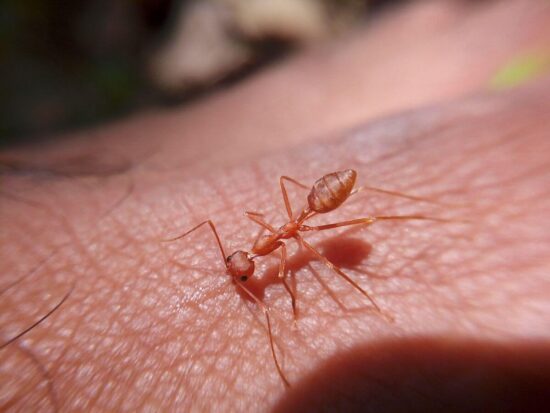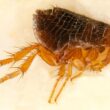Getting bitten by an ant can be confusing and painful. You might wonder what ant bites look like and how to tell them apart from other bug bites. Different types of ants create different marks on your skin, so knowing what to look for can help you treat the bite properly.
Most people use the word “bite” when talking about ants, but many ants actually sting instead of bite. When they sting, they inject venom that causes pain and swelling. Some ants bite with their strong jaws and then spray acid into the wound. Either way, the marks they leave behind have certain patterns that can help you figure out what kind of ant got you.
Understanding what ant bites look like is important because some ant species can cause serious reactions. While most ant encounters just leave small red bumps that go away in a few days, others can create painful blisters or even dangerous allergic reactions. Let’s look at how to identify the most common types of ant bites you might encounter.
1. Fire Ant Bites
Fire ants create some of the most recognizable marks on human skin. These ant bites look like small red welts that show up within 20 minutes of being stung. The welts start as tiny bumps but quickly turn into something much more noticeable.
Within a few hours, these ant bites look like white or yellow pus-filled blisters. The blisters have a unique bullseye appearance with a dark red circle around an elevated, light pink to white center. Fire ants often sting multiple times, so you’ll usually see several bites clustered together in a circular or semicircular pattern.
You’ll most likely find fire ant bites on your feet, ankles, and legs since these ants live in ground mounds. The initial sting creates an immediate burning sensation that gives fire ants their name. After the burning stops, intense itching takes over and can last for days.
The pus-filled blisters are the key feature that sets fire ant bites apart from other insect stings. These pustules last about 7 to 10 days and should never be popped or scratched open, as this can lead to infection.
- Attracts and kills ants you see and the colony you don’t
- Fast results—see fewer ants in just days
- Ready-to-use stations, no mess or setup needed
- Perfect for kitchens, bathrooms, and any ant hotspots
2. Carpenter Ant Bites
Carpenter ants create much milder marks compared to fire ants. These bites appear as small red bumps that look similar to pimples. Sometimes carpenter ant bites can be pea-sized red blemishes, but they’re usually smaller and less dramatic than other ant bites.
The main thing that sets carpenter ant bites apart is the burning sensation that comes with them. When a carpenter ant bites, it injects formic acid into the wound, which creates a sharp pinching feeling followed by a prolonged burning sensation. This burning can last several hours, even though the bite itself isn’t very large.
Carpenter ant bites are actually pretty rare because these ants prefer to avoid humans. You’re most likely to get bitten when gardening or working around wooden structures where they build their nests. The bites usually happen on hands and arms rather than legs and feet.
Most carpenter ant bite symptoms fade within 24 to 48 hours. The red bump might break the skin slightly, but serious complications are uncommon. These bites respond well to cold compresses and over-the-counter pain relief.
3. Harvester Ant Bites
Harvester ants pack the most powerful punch of any ant species. These ant bites look similar to fire ant welts but tend to be larger and cause more swelling. What makes harvester ant bites unique is the incredible pain they cause.
The venom from harvester ants is about 20 times more toxic than honey bee venom. When they sting, the pain can last anywhere from 4 to 12 hours, which is much longer than most other insect stings. The bite area often develops unusual symptoms like localized sweating and raised hairs around the injection site.
Some harvester ant species leave their stinger in the wound just like honeybees do. If you see a small black stinger sticking out of the bite, you’ll know it was probably a harvester ant. The stinger needs to be removed carefully to prevent more venom from entering your system.
These ants live mainly in the southwestern United States and prefer open, sandy areas. Harvester ant bites usually happen when people accidentally step on or disturb their large, visible mounds. The intense pain and long duration make these bites impossible to ignore.
4. Little Black Ant Bites
Little black ants create some of the mildest bites you’ll encounter. These ant bites look like tiny red spots that cause minor itching. The bites are so small that they’re often mistaken for other minor skin irritations or barely noticed at all.
Since little black ants are very small, their bites don’t pack much punch. The red spots they leave behind usually fade within 24 hours and rarely cause any lasting problems. You might feel a slight pinch when they bite, but the pain goes away quickly.
Little black ant bites are pretty uncommon because these ants try to avoid conflict with humans. They prefer to run away rather than fight when disturbed. When bites do happen, they’re usually on exposed skin like hands and arms.
The main challenge with little black ant bites is telling them apart from other small insect bites. The tiny size and quick healing time are the best clues that a little black ant was responsible.
5. Field Ant Bites
Field ants create red, swollen bites that come with a distinctive burning sensation. These ant bites look like raised red bumps, but what makes them special is the intense burning feeling caused by formic acid.
When a field ant bites, it sprays formic acid directly into the wound. This acid creates a sharp burning sensation that can last for hours. The chemical reaction also makes the bite area more swollen and red compared to simple puncture wounds.
Field ant bites are usually larger than typical ant bites because of the acid reaction. The swelling can spread beyond the actual bite site, creating a red, inflamed area that’s warm to the touch. These bites commonly happen on hands, arms, and legs when people are working outdoors.
The good news is that field ant bites respond well to treatment. Cold compresses help reduce the burning sensation and swelling. Anti-inflammatory medications can also help control the reaction to the formic acid.
- Attracts and kills ants you see and the colony you don’t
- Fast results—see fewer ants in just days
- Ready-to-use stations, no mess or setup needed
- Perfect for kitchens, bathrooms, and any ant hotspots
6. Sugar Ant Bites
Sugar ants create some of the smallest and mildest bites you’ll encounter. These ant bites look like tiny red marks that are barely visible on the skin. Since sugar ants are only 2 to 15 millimeters long, their bites are proportionally small.
Sugar ant bites usually don’t cause any pain, but they can trigger allergic reactions in some people. The bites appear as small red dots that might cause slight itching. Most people don’t even notice when they’ve been bitten by a sugar ant.
These bites typically happen around food sources or in kitchen areas where sugar ants go looking for sweets. The ants are more interested in finding food than fighting with humans, so bites only occur when the ants feel directly threatened.
Sugar ant bites usually fade within a few hours and rarely need any treatment. The main concern is making sure the small red marks aren’t actually from more dangerous insects or spiders.
7. Argentine Ant Bites
Argentine ants create minor brown or reddish marks when they bite. These ant bites look like small, barely noticeable spots that cause very little pain or irritation. Argentine ants are small brown ants that generally try to avoid contact with humans.
The bites from Argentine ants only happen when their nests are heavily disturbed. Even then, the bites are so mild that many people don’t realize they’ve been bitten. The small marks they leave behind are proportional to the ant’s tiny size.
Argentine ant bites can occur anywhere on the body, but they’re pretty uncommon overall. The ants prefer to run away rather than fight when they encounter humans. When bites do happen, they’re usually on hands or arms during gardening or outdoor work.
These bites typically don’t require any treatment and fade quickly on their own. The mild nature of Argentine ant bites makes them more of a curiosity than a real concern.
8. Pavement Ant Bites
Pavement ants create small, dark-colored marks when they bite. These ant bites look like tiny dark spots that cause minor irritation and itching. Pavement ants get their name because they often build nests under sidewalks and driveways.
The bites from pavement ants aren’t particularly painful, but they can be annoying. The small dark marks they leave behind might itch for a day or two. These bites are more of a nuisance than a serious threat to your health.
Pavement ant bites often happen on lower parts of the body like feet and ankles when people walk near their nests. The ants are small and dark brown, which matches the appearance of their bites.
Most pavement ant bites resolve quickly without any treatment. The short duration and mild symptoms make these bites easy to manage at home with basic first aid.
9. Flying Ant Bites
Flying ants can bite just like their ground-dwelling relatives, but the timing is what makes these encounters special. Flying ant bites happen during late spring and early summer, especially after rain when humidity is high.
These ant bites look similar to bites from the same species of ground-dwelling ants. The difference is that flying ants might be more defensive because they’re focused on mating and starting new colonies. They don’t actively seek out humans to bite, but they will defend themselves if they feel threatened.
Flying ants can be any species of ant during their reproductive phase. Fire ants, carpenter ants, and other species all produce flying versions when they want to expand their colonies. This means flying ant bites can range from mild to severe depending on the species.
The seasonal timing and the presence of winged ants in the area are the main clues that you’re dealing with flying ant bites. Treatment should match whatever species of ant did the biting.
10. Bull Ant Bites
Bull ants are found mainly in Australia and are known for being extremely aggressive. These ant bites look like large, painful welts because bull ants are much bigger than most other species. They’re more aggressive than fire ants and can move incredibly fast.
Bull ants can deliver multiple stings per ant, which creates clusters of painful welts. The bites are larger and more severe than most North American ant species because of the bull ant’s size and aggressive nature.
These ants pose a high risk for severe allergic reactions and can even cause anaphylaxis in sensitive people. Bull ant bites are a serious medical concern that often requires professional treatment.
If you’re in Australia and get bitten by large, aggressive ants, seek medical attention quickly. Bull ant bites are not something to treat lightly at home.
11. Timeline Based Identification
Understanding how ant bites change over time helps with identification. In the first 30 minutes after being stung, you’ll feel sharp pinching or burning pain right away. Itchy bumps or welts usually develop within about an hour of the initial sting.
During the first 24 hours, the bites continue to change. Blisters start forming where the bumps were located after several hours. About a day later, these blisters fill with yellow or white pus-like fluid, especially with fire ant stings.
The long-term healing process takes 7 to 10 days for most ant bites. The blisters gradually go away during this time. However, there’s always a risk of secondary infection if the bites get scratched open or aren’t kept clean.
This timeline helps distinguish what ant bites look like from other insect bites that follow different patterns. Most other bug bites don’t develop the characteristic pus-filled blisters that fire ants create.
- Attracts and kills ants you see and the colony you don’t
- Fast results—see fewer ants in just days
- Ready-to-use stations, no mess or setup needed
- Perfect for kitchens, bathrooms, and any ant hotspots
12. Distinguishing Ant Bites from Other Insect Bites
Knowing how to tell ant bites apart from other bug bites can save you time and worry. Ant bites form marks that look like pimples and are elevated from the surrounding skin. Bee stings leave small marks where the stinger entered the skin, and sometimes the stinger stays behind.
Ants can sting multiple times in one attack, while most bees only sting once before dying. This difference in behavior creates different patterns on your skin. Multiple ant stings often appear in clusters, while bee stings are usually single marks.
Mosquito bites are usually small, raised, and itchy, but they don’t develop the pus-filled blisters that fire ants create. Ant bites are typically a one-time occurrence that fades over time, while mosquito bites might increase in frequency as the bugs continue to feed.
Flea bites appear as red spots surrounded by reddened halos and are often found on legs and feet. However, flea bites typically come in clusters without the pustule formation that makes fire ant bites so distinctive.
Spider bites show two puncture marks close together from the spider’s fangs. Spider bites may develop blisters or an extending rash after a day, but they start differently than the pimple-like marks that ants create.
When to Seek Medical Attention
Some ant bite situations require immediate emergency care. Call 911 right away if you have difficulty breathing, swelling of your face or throat, chest pain, or dizziness. These are signs of anaphylactic shock, which can be life-threatening.
Other emergency symptoms include sneezing, wheezing, hives, nausea, vomiting, diarrhea, or sudden anxiety after being bitten. If you experience any of these symptoms, don’t wait to see if they get better on their own.
You should also seek follow-up medical care if you notice signs of infection. These include increasing redness, warmth, pus, or red streaking extending from the bite site. Bites that get worse after 24 to 48 hours instead of better also need professional attention.
Multiple bites covering large areas of your body or bites in sensitive areas like your face should be evaluated by a healthcare provider. Children are often more sensitive to ant bites and may need medical care sooner than adults.
Prevention and Treatment
The best way to deal with ant bites is to prevent them in the first place. Wear protective clothing when working outdoors and tuck your pants into your socks when walking through areas with known ant problems. Use insect repellent on exposed skin and be careful when lifting objects off the ground.
Never disturb ant nests or colonies on purpose. Most ant bites happen when people accidentally step on mounds or stick their hands into areas where ants are living. Being aware of your surroundings can prevent most ant encounters.
If you do get bitten, wash the bite area with antibacterial soap and water right away. Apply ice to reduce swelling and take antihistamines or use topical hydrocortisone cream to control itching. Most ant bites can be managed successfully at home with these basic steps.
Remember that while most ant bites are minor inconveniences, some species can cause serious reactions that need immediate medical attention. When in doubt, it’s always better to seek professional help rather than try to tough it out at home.
Learning what ant bites look like and how to identify different types helps you respond appropriately when bites occur. With proper identification and treatment, most people recover from ant bites without any lasting problems.



